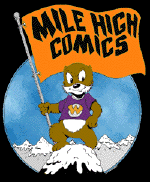Interview with Joe Kubert
by Bob Gough, Contributing Writer
|
The promise of youth has always been the hallmark theme throughout the sterling career of Joe Kubert. Joe started drawing for comics at age 12 and over 60 years later, his world-famous art school hones the skills of young artists who wish to make their own contributions to the field. And the heroes Joe created or brought into the limelight - Tor, Sgt. Rock, Hawkman, to name just a very few - provide hours of entertainment for fans of quality comic art, young and old alike. That dedication to excellence has passed on to his sons, Adam and Andy Kubert, who are now celebrated artists in their own right. Mile High Comics caught up with Joe and he kindly agreed to answer a few questions about his work and his career: Mile High: First off, thank you for your time. How is business at your school, the Joe Kubert School of Cartoon and Graphic Art (www.kubertsworld.com/index.asp)? How have students responded to the correspondence courses you've added? Both very well. You've got some top-notch instructors there, including Tom Mandrake (Martian Manhunter, the Spectre) and your sons. How do you choose instructors for your school?
Tom was involved in the correspondence course -- specifically, the Horror course.
You started drawing for comics at an early age. What's the most likely commercial outlet now for a young artist such as you were and why? There are no commercial outlets available for anybody as young as I was. The whole comic book publishing business was quite different 50-60 years ago. The opportunities that I had, to get into the business at a very young age no longer exist. You once told Al Dellinges (Joe Kubert: A Golden Age Index) that you still approach each job with the hope and desire that you'll be better than your last and that you find it important to constantly be changing and upgrading your work. Considering your career began in 1942, and you've contributed to just about every comic title there is, what more can you improve on? Every artist should try to improve for as long as he can draw. We need to be continually learning, changing and adapting. It's what every artist should strive for, and I continue to do so. You've said many times your favorite character to work on was Tor which you created. It really shows your dedication to figure drawing as a basis for the human forms you draw. Can you comment on why figure drawing is so important compared to learning form from other comics or cartoon strips? Before you can successfully exaggerate the human form, you have to know what the human form look like correctly. Otherwise the exaggerations will look wrong. If you try to learn anatomy from these exaggerations, then you're simply compounding the exaggerations and the drawings will look incorrect. Your dedication to figure drawing explains the fluidity and natural quality of the human elements of Tor. Where did you pull the inspiration for your animal forms from? From animals. (chuckles) Fair enough. Most people know you for your work on war titles such as Our Army at War, Star Spangled War Stories, Our Fighting Forces and G.I. Combat, among others, with characters such as Sgt. Rock, Enemy Ace and the Unknown Soldier. Which of those titles or characters was your favorite to work on and why? Sgt. Rock. Because I've been doing him the longest. We read recently that you may be returning to Sgt. Rock? When and how? This new project involves Brian Azzerello as the writer in a hardcover book containing 120-130 pages. It will be published by the end of this year, beginning of next. Hawkman recently began yet another renaissance at DC Comics. You're known as the definitive artist of the Aerial Ace, going back to Flash Comics #62 in the Golden Age and then again, reviving the character in Brave and the Bold #34 in 1961. Carter Hall or Katar Hol has been through other revivals before, notably in the 1980s with Tim Truman's Hawkworld. What do you see as the character's seemingly immortal appeal? Good stories, and hopefully, equivalent artwork. Your style on Hawkman's wings arguably are what contributed more than any other single artistic element to the book's popularity. How did you achieve it? Pass. You pioneered 3D comics with Mighty Mouse in 1953. It was also one of the first comics to ever be reprinted, selling over a million copies. What other firsts are in your portfolio that we might not know about? I don't think I've done anything equivalent to introducing the 3-D process to comics. What do you think is the most important change in the comic book industry in the past 60 years for good or for ill and why? The use of computers, for good and for ill. Joe, thank you again for your time.
|

